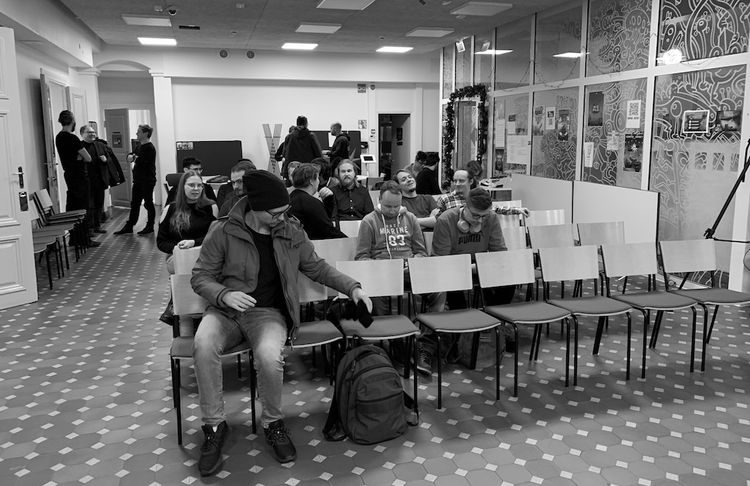EGD Special: Ask Me Anything #1


In today’s episode, I’m going to be addressing some Ask Me Anything questions that I’ve been asking for on the Elite Game Developers newsletter. I sent out a survey form, where I asked subscribers of the newsletter to send out questions related to gaming studios, how to build successful businesses, and all things related. So let’s get going with this first episode.
Transcript
Q from Danish
Hi Joakim, Saw your Youtube video on “How To Minimize Risks In Games Business” Had a lot of good points to take into account. Thanks! I had one question if you can answer, there is a DeltaDNA video called “Player Engagement: The Good, The Bad and The Great” where they mentioned that early high session time is a bad thing in games (https://youtu.be/hASrSINca3A?t=922) whereas, in your video, it somewhat speaks the opposite (https://youtu.be/i6sgXqgTBhc?t=3623). Can you help me understand? Is it contradicting, or am I misreading it?
A from Joakim
Regarding your question, I would say that both are true. For DeltaDNA: if you don’t have sessioning mechanics in place to keep players engaged, and not burning out because the game is giving out too much content immediately to blow through. Sessioning mechanics for example in hyper-casual are video ads between levels, which are a natural break for the player, so that they aren’t in an intense gameplay all the time without any breaks.
Another bad first session example: Supercell’s Gunshine game had a long tutorial where you’d go through lots of training with your character. The game ended up having very long first sessions. That’s not the only reason why Supercell had to wait to ship Hay Day and Clash of Clans to do well, but it was a big factor in that game not doing that well.
So you want lots of minutes on the first day, meaning day zero, but you don’t want them all in one session.
Q from Aycan
How do you validate product/market fit?
A from Joakim
Product market fit was coined in the early 2000’s by Andy Rachleff, who is currently the CEO and co-founder of Wealthfront. It basically means that you have something special in your hands that customers will want so badly that they are willing to pay a premium for what you have.
“You often stumble into your product/market fit. Serendipity plays a role in finding product/market fit but the process to get to serendipity is incredibly consistent. What we do is teach that incredibly consistent process.” Andy Rachleff
In gaming, a game that has product market fit, is basically a game that generates a consistent and predictable profit for a foreseeable future. Before the days of f2p, you’d have to work on a game until it was finished and in the stores to see if it would become a hit game.
Now, with the advent of metrics for games, you can measure certain key performance indicators, known as KPIs, to measure.
Retention is the most obvious one to start with, since it’s the least effort to reach. You can build an experience that lasts for a few days, and then measure how many players are returning to your game, on the day after they installed the game. That is the first step in validating product market fit.
Then you start looking at D3, D3/D1 ratio, then D7, then D30. There are many ways to calculate what is good enough, aka. you’ve reached product-market fit. I talk about more of these in my free eBook the Advanced Retention Metrics, link in the show notes.
1) D1 is above 60%
2) D3/D1 ratio is above 70%
3) D30 is above 10%
You can make a business out of this. To pay salaries. Finally, to say you have an enormous hit, you look at CAC to LTV. Differs for hyper-casual, casual, mid-core, hardcore.
Question from Ehsan
It has been a while that I am thinking about our startup story. I wanted to ask you what kind of stories do you like to invest in? How could we find our story?
Answer from Joakim
I have this article called the twenty reasons why investors will say no. Here’s the link to that one.
Reason number 10 was that they found is not being a storyteller “Don’t be humble and unexcited”. You should sell your story to the investor. Tell a compelling story. Investors bet on big dreams. You want to create a situation where the investor is having the dream of the story you just told them. Avoid being arrogant. Make sure that you have a story where there are a lot of winners, and you can take a slice of an ever-growing market. Example: Amazon didn’t pitch about owning Whole Foods when the company started in 1994. They talked about selling books over the internet. But they did mention that if they’d achieve that, they could take on more businesses.
I’ll give two recent examples of stories from companies I’ve talked to.
The first story was from a team that had built a diverse culture intentionally. They used to work in game studios where the lack of diversity was evident in the way that interesting ideas would not be shared as there was a bias for a consensus on “this is how games should look like.” They intentionally wanted the new company to have diverse points of view, to have a bigger chance at finding a new idea that could be turned into a game. Thinking, talking, and doing things differently was their insight and they built the company around that.
The second story was from a startup with a group of beginners in the games industry. Four founders are all something like 23 to 24-year-olds. They started the company during their time at University where they studied game development. They went to mobile, but all their first games didn’t really work. They spent months building the games and then ended up not having great retention numbers. They decided that they need to learn what the pros would do in this situation. They told me that they stumbled upon Elite Game Developers and started reading the articles and watching the videos, listening to the podcast episodes. They were inspired by the rapid development approach from Traplight. The Traplight approach is to first focus on having a game that works on day-0, and have good enough session metrics. Then they move to Day-1, then Day-3, and d3 / d1 ratio. They told me that they also changed the way that they discussed game concepts and prototypes internally, becoming more critical about their own biases and focuses on validating their games through MVP launches and metrics. They had also read several of my articles, like the B-team article and how they really felt that they’d been that team who was wandering in circles in the desert. Like I mentioned in the article about the C and D teams.
Both stories really resonated. It showed that the teams were really thinking about the company and its identity and how to have insights that others aren’t having.
Question from Yolan
How viable is it start a new startup during the pandemic? How likely is it to attract outside investment during the pandemic for said early stage startup? Does it have any benefit or drawbacks to wait for a post Covid world?
Answer from Joakim:
I’m going to focus on how things changed with Covid and how I believe things will change for the future.
In early 2020, we went from having GDC flights and hotels booked, to a world of Zoom calls and virtual conferences. I believe that the whole games industry, and the whole tech world, have learned to be more streamlined with how we conduct meetings. In the previous world, we were dedicating several days every month for travel. Either going to that coffee shop for a meeting, or to the office, or to these game conferences. Now, we can be in our comfortable clothes, at home and talk over video calls.
Specifically for fundraising, the investors have learned new ways to read signals from the founders. We do more reference checks when haven’t physically met the person. Even, in the pre-covid world, we needed to learn more about the founders through reference checks. How they acted in stressful situations, how they worked in teams, were they team players, and those kind of things. The need for reading the founder hasn’t actually changed that much.
With all this time saved from not having to sit on a bus, a train or an airplane, everybody gets more things done. If we have productive systems in place, we can accomplish more and have other things to think about, or to work on. For investors, it can mean more deals get done. More companies get attention.
In the post-covid world, which should be happening soon, I think we won’t want to move everything to the way that it was. We won’t want to schedule all the pitch meetings to physical real world conferences, as everyone has now seen how inefficient that was. We’ll do most of the meetings on Zoom, even in post-covid, but the personal relationship building will be the main driver for real-world conferences.
I recently read a book called Culture Map, which is a really fascinating book about how different cultures around the world work and interact with each other. The books talk about how business relationships are developed around the world, some cultures prefer that business relationships are developed as like a friendship would be developed. The physical closeness and interaction are on a totally different level when you are hanging out together, versus a 30 min Zoom call.
To answer your question, is there a benefit or drawback to waiting for a post-Covid world? I would say that no since investors have adapted to look for great companies on Zoom and I don’t believe that that system will go away in the post-Covid world. We will still have a lot of Zoom calls and investors will prefer those more than going back to the pre-covid face-to-face meeting system.
Question from Haga
What kind of changes to games have you seen take them from bad D1 to great D1 retention?
Answer from Joakim
That’s an interesting question, and there’s several ways to answer the question.
Before answering, let’s tackle what Day-1 retention means. You have a game that a player starts to play. You register that player in your analytics system as someone who started the game, on Day-0. They play the game have much they like. But then, what you are measuring with Day-1 retention is to monitor if the player will come back on the following day to play the game. Day-0 is the starting day and D1 is the following day. Day-3 retention would be the three days after Day-0, and so forth.
Let’s get back to Day-1. Why are we looking at Day-1? Because we want to understand how attractive and engaging your game is. Are people willing to continue playing the game after they’ve slept over it for night.
A few things often come up about Day-1 measuring:
First: why are we looking at Day-1? What if the player comes back on Day-2, but they still love the game. Isn’t being strict about Day-1 a bad idea?
Industry benchmark, you can measure how well you are doing compared to others.
Second: How about we’d look at Day-1 and any day after D1?
If we’d look at Day-1 as a sort of a rolling-retention, where we include D1 and any day after that as D1 retention, we would have more knowledge about player retention. But there’s a few problems: when you are doing changes to your game regularly or you are still in soft launch, rolling retention will constantly improve as more days are added. You’d have to wait for an arbitrary length of time to measure an accurate D1 that isn’t changing.
Third: what is enough players to measure an accurate Day-1?
I’d always aim for having a few hundred players, trying out the game. Like, 200 is minimum, 300 is getting better, 400 is enough. You shouldn’t worry about spreading the installs over several days, but what you then want to do is sum up the retention of all those days, not cherry pick the best days. Like we had 100 installs on Monday with D1 as 51% and then the rest on Tue and Wed were only at 43%, so let’s put 51% into out pitch deck. Rather, sum up Mon, Tue and Wed, all the Day-0 new players, and how all those players returned on their individual day-1s. Some analytics platforms call this the weighted average. Use that in your pitch deck.
Now, why does D1 matter? It’s one of the main Key Performance Indicators for games and it’s easily comparable between other games. Everyone in mobile games knows that Day-1 40% is the minimum but still needs work, above 50% is really good and can be built into a business. Over 60% is amazing and all the investors will be throwing money at the developers.
And now to your question “What kind of changes to games have I seen take them from bad D1 to great D1 retention?”
The answer is that I haven’t seen many big changes. The big change usually happens when the developer had launched the game just way too early, without critical components. Like they’d be missing the tutorial, and the game goes from 43% d1 to 49% d1.
One thing I see a lot with inexperienced teams is when they get 20% to 30% day-1 numbers for their games. They are often dumbfounded and don’t know what they should have done differently.
In these situations, when I keep digging into the ways that the founders built up the game, I often discover that the game doesn’t feel that exciting and it has core gameplay issues which might be confusing to players, or that the game is pretty much been experienced after the first few levels.
The way to improve from a 20% to 30% day-1 is to become more knowledgable on how mobile games work. The UX best practises, what keeps people enjoying certain games. You play the games, you discuss your hypothesis and read up on content. DoF has many articles talking about games, Javier Barnes writes a lot about gameplay.
That’s what I’d say. The biggest difference to improve D1 is that you become more knowledgeable on what success looks like on your platform and you need to know what is missing, so that you can inject your own secret sauce to your games.
Question from Goran
I am preparing an innovative casual, puzzle, pattern-matching mobile game for several years and finally got the connection to the VC Fund for the seed funding.
After presenting my game project, the Fund’s managers have validated it as ‘viable” and now it goes to the Board members. The project consists of several games in the casual and mid-core genre. The entire process to develop all scheduled games could take 5 years roughly. We are negotiating the development of the casual game, which is the first on the list. It will take 2 months for the pre-development phase and 8 months for the global launch.
I expect the project will need as well the Series A funding for UA in the global launch stage. They stated readiness to invest in Series A too (not confirmed, will be discussed).
Q: How much equities is a fair share for the seed stage when the funding amount is between EUR 350-450K? And what is the best way or procedure to validate my company, meaning what are other options to complete a deal successfully?
Answer from Joakim
Well Goran, I think you are asking two questions here.
Let me first tackle the fair share question. Goran asked “how much equities is a fair share for the seed stage when the funding amount is between EUR 350-450K?” In any kind of a funding round where you are raising hundreds of thousands or millions, you should always expect to give out 20% of the company. It is a fair number, as then the ownership of the investor will not dilute too much in the future funding rounds. Investors know from past experiences that a half-a-million dollar round usually means that there will be two more rounds, minimum, before the company might not need more funding. But sometimes there will be three more rounds. With each round, existing investors and founders will dilute in their ownership. 20% is fair for both investors and founders, since both will own enough that future investors will not look a cap table where existing investors already own too much, and they will be reluctant to invest.
And then Goran asked, “And what is the best way or procedure to validate my company, meaning what are other options to complete a deal successfully?”
The best way to validate your games company is to validate your games. Building an MPV, launching it, and measuring the retention numbers. If that isn’t an option and you need to raise before you start to develop your games, you’d need to strengthen the position to become more attractive for investors.
If I look at game companies that raised money before they had retention numbers, not to mention any revenue, the companies all looked quite similar. The founding team had many years of experience from working in gaming, from tech, product and marketing. Preferably from all of those areas. And they’ve shipped games and they know what they are getting into.
Investors are playing a risk minimization game, and one big risk minimizer is that the team has built games before, have launched games and have marketed games. That means that the investor will have confidence in the team to do what they are saying they will do.
If you don’t have a team like that, then you could work on bringing people into the team who are entrepreneurially driven, want to have their own startup and are looking to make similar games as you are. So you join forces and you become a much better candidate for funding in the eyes of the investor.
It’s not always necessary to have those great retention numbers. If you can prove out that you have a process in place to build towards a game that works, that is also a risk minimizer. You’ve already built games, tested them, you are knowledgeable about the market and you can communicate this to the investors.
If you have more questions, please do send them to the questionnaire. You can find the link by going to elitegamedevelopers.com/askmeanything typed together, without any spaces.
.





